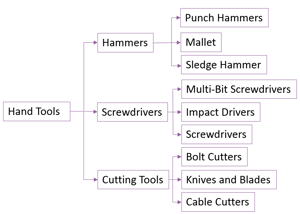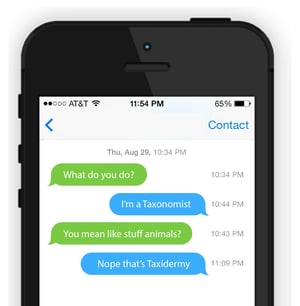The term “taxonomy” is used in many ways, and therefore can be confusing. Taxonomy has many use cases and many different functions. Google defines taxonomy as:
“The branch of science concerned with classification, especially of organisms; systematics. The classification of something, especially organisms. A scheme of classification.”
Wikipedia says it’s
“The practice and science of classification.”
What it generally comes down to is a how we define and organize objects, be they organisms, products or terms.
Objects need definition for many practical reasons, some of which are fundamental to survival—which foods can be eaten safely? Which animals are dangerous? Sometimes organizing information helps society develop. Which materials can be useful for building? Which textbooks are most instructive? We need to know what we are dealing with. From there we understand how to describe them, the use of the objects and then any actions that need to be taken from or for the objects.
5 uses of taxonomy in business
Below are several different applications of taxonomy in business. Essentially they all accomplish the same objective—to provide a hierarchal list of objects or knowledge—but the uses vary widely and they also may intersect with each other.
1. Classification
A frequent use of taxonomy is as a hierarchy of categories for classification. We see this in several different areas, such as a classification of animals or plants, or a classification of products. The classification taxonomy is often considered the primary taxonomy and is based on “is-ness” for classification purposes. This “is-ness” is based on what the object IS rather than what it is used for. (The term is often flooded by internal company business units and as marketing jargon, which is not customer focused.) The hierarchy is often shown as a tree structure with parent-child relationships, getting more specific with each level of the hierarchy.
When products are onboarded in a product information management (PIM) system, they generally are assigned global attributes, such as a description and brand. Once they are classified to a category in the taxonomy, they should then pick up category-specific attributes such as watts for lighting products, or type of material for apparel. Category-specific attribution prevents the needless white noise that using the terms in the context of global attribution could cause. No one needs to know the wattage of a shirt (unless it’s a really cool shirt). Having that attribute when it’s not needed would just cause confusion.
Another case where object categories are used is with content. A company may have many documents stored in SharePoint. Classifying those documents as a document type such as resume or invoice allows the correct rules of metadata and governance to come into play for that particular piece of content. Such a category would also allow for assigning metadata such as topic or company department to improve findability.
Below is an example of a taxonomy hierarchy for a specific type of hammer:
Taxonomy: Hand Tools –> Hammers –> Punch Hammers
Punch Hammer Attributes: Weight, Overall Length, Head Length, Handle Material, Head Material, Magnetic (Y/N)
Here is a broader tree view:

2. Site navigation
Taxonomy can also be used for navigation, providing a pathway for an end user to find the product or content. Navigation taxonomy often works in conjunction with the classification taxonomy but adds layers of “poly-hierarchy” – an additional set of control terms that provide the end user with multiple avenues to find the product, depending on their user persona.
One way to do this is by adding a taxonomy for application, or the “about-ness” of the product. If we take the example above, punch hammers, and apply this to a crafting website, a specific application for this item may be leatherworking. Under an application entitled “Leatherworking,” a secondary level could be added for “Belting Equipment” with a list of products the website sells for that particular application. These might include leather, buckles, leather cutters and punch hammers.
A secondary taxonomy may also be role based. For example, under “Finance Department,” another level could be created, with “Accounts Receivable” and “Accounts Payable.” This hierarchy could be combined with document types, so that a user could find “Invoice” or “Journal Entry” directly under “Finance Department.”
3. Controlled vocabulary
A hierarchy of terms and definitions is a controlled list of values (CLOV), and controlled vocabulary are also ways to describe this use case. This type of taxonomy allows for consistency in data, which can get messy if your company does not govern data through style guidelines. For example, Illinois can be IL, IL-Illinois, or Ill or some other format. Having a terms taxonomy creates a standard format from which users can choose. The result is a clean set of data, free of ambiguity.
This approach reduces the possibility that result sets will be missing items. Without terms and definition, someone searching for all of the realtors in Illinois, a searcher may only receive those tagged with “Illinois” and not “IL”. The realtors missing from the result set will lose out on business, thus contradicting the original intent of the search site!
These attributes are also referred to as “facets” and can be of use in filter navigation on a search platform, whether it be content such as in SharePoint or product search on an e-commerce site. The filters need to be optimized for end user experience, which means the least amount of clicks possible. A gaming company user is trying to find all content related to the topic “Skyrim,” needs to be able to just click one selection rather than Skyrim, Elder Scrolls: Skyrim, Skyrim Remastered, Elder Scrolls V, etc. One assigned phrase for one click is the fastest path. Some platforms allow for multiple tiers in CLOV, which is very useful for categories of color. Paint has many fancy names, but if end users want to see “blue,” they should be able to click on “blue” and then see a second tier of variations on blue such as “Morning Blue Sky,” “Mediterranean Sea Blue,” or “Midnight Blue.”
4. Synonyms
Taxonomies can be used to compile sets of terms that are similar in meaning. This use of taxonomy can also be used for data consistency as it flags one of these terms as the master. If someone does a search for Anakin Skywalker, a set of synonyms such as Darth Vader can also bring up the same results due to the fact that they are set up as synonyms.
Synonyms Taxonomy can be used in concurrence with Terms Taxonomy as well. These two items are very similar in nature, but while the Terms Taxonomy allows for one entry of the specified attribute value, the synonyms list allows for many words to be linked together, so if you enter any of the synonymous words the system knows what ‘Master’ word it is linked to. The aforementioned Skyrim example would be especially useful. Rather than functioning as a filter, if the end user entered Elder Scrolls V, then the terms taxonomy would see the relationship between Elder Scrolls V and Skyrim and bring up the subsequent content. The admin or uploader of the document would just need to assign Skyrim as the tagged topic content and the synonyms taxonomy would enable the system to pull up all Skyrim and synonymously termed documentation.
5. Security
This use looks very much like the Terms use on the outside but has a different purpose. The admin creates a list of users or user groups, usually a CLOV, and assigns them to a set of security rules. These rules can apply to objects and can specify who has access to view, read, and edit. The admin may create a user group for “Human Resources” and have the document type “Resume” only viewable to them, while the document type “Public White Paper” under Marketing may be viewable to all users, but only editable to “Marketing Specialist.”
What does a taxonomist do?

(Hint: it isn't stuffing animals!)
A key distinction that is critical to be understood, as all taxonomists will know, is the difference between a taxonomist and a taxidermist. Why the similarity in the sound of these terms? According to vocabulary.com they both come from the Greek word “taxis” which means “arrangement.” Taxonomist is most commonly used to describe someone, often in biology, who classifies animal and plant genres, while a taxidermist arranges skin, literally (that’s what it means in Greek). Taxis = arrangement and derma = skin. A taxonomist is engaged in the science of arranging data. In “taxonomist” we see again, taxis = arrangement and then nomos = science or law. So we arrange science or information. In the case of the biologist, the arranging is focused on animal and plant genres.
A taxonomist is often the admin of the taxonomy, and may serve as the gatekeeper, the librarian, and the knowledge manager. If a new term, category, or object needs to be added to the taxonomy, the taxonomist is head of the governance in place to add the term. The taxonomist makes sure the added items are necessary, follows style guidelines and goes through the approval process. In addition, the taxonomist often has an ongoing responsibility to verify the health of the taxonomy and associated data and leads efforts to maintain and clean the data.
At EIS, we arrange data, and we take it seriously as a science. If your company needs help figuring out what kind of taxonomy would bring it new business value and efficiency, please get in touch with us. We can help analyze your company’s present state and guide it through the transition to a more organized and productive state.
To learn more about how we apply the science of organizing information to solve business problems, check out our white paper: Attribute-Driven Framework for Unified Commerce.
